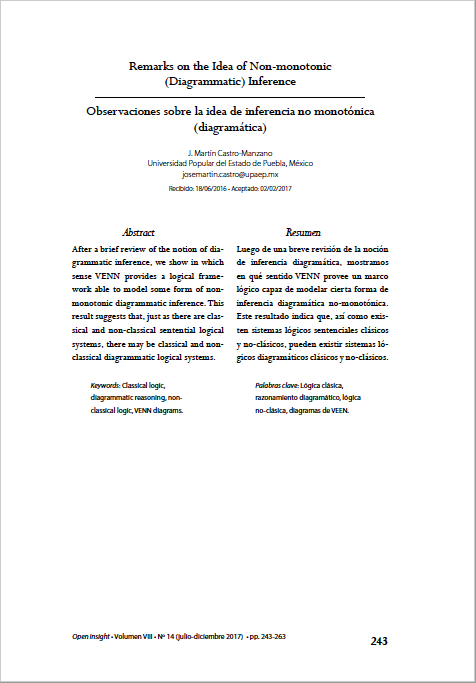Observaciones sobre la idea de inferencia no monotónica (diagramática)
Resumen
Recibido: 18/06/2016 • Aceptado: 02/02/2017Luego de una breve revisión de la noción de inferencia diagramática, mostramos en qué sentido VENN provee un marco lógico capaz de modelar cierta forma de inferencia diagramática no-monotónica. Este resultado indica que, así como existen sistemas lógicos sentenciales clásicos y no-clásicos, pueden existir sistemas lógicos diagramáticos clásicos y no-clásicos.Citas
Allwein, G., J. Barwise. (1996). Logical Reasoning with Diagrams, Oxford University Press: New York.
Bochman, A. (2011). “Logic in nonmonotonic reasoning” En Non-monotonic reasoning. Essays celebrating its 30th anniversary. College Publications.
Lagrange, J.L., A.C. Boissonnade, V.N. Vagliente. (1997). Analytical Mechanics. Kluwer Academic: Dordrecht.
Bök, A.F. (1766). Sammlung der Schriften, welche den logischen Calcul Herrn Ploucquets betreffen. Frankfurt U.A.
Descartes, R., V.R. Miller, R.P. Miller. (1983). Principles of Philosophy. Reidel: Dordrecht.
Dieudonné, J. (1960). Foundations of modern analysis. Academic Press: New York.
Dung, P.M., (1995). “On the Acceptability of Arguments and its Fundamental Role in Nonmonotonic Reasoning, Logic Programming and n-Person Games”. En Artificial Intelligence, 77(2), 321-357.
Englebretsen, G. (1992). Linear Diagrams for Syllogisms (with Relationals). En Notre Dame Journal of Formal Logic, 33(1), 37-69. DOI: 10.1305/ndjfl/1093636009
Moore, R.C. (1985). “Semantical Considerations on Nonmonotonic Logic”. En Artifical Intelligence, 25(1): 75–94.
Gardner, M. (1958). Logic Machines and Diagrams. McGraw-Hill: New York.
Hamilton, W., H.L. Mansel, J. Veitch. (1860). Lectures on Metaphysics and Logic. Gould and Lincoln: Boston.
Hammack, R. H. (2013). Book of Proof. Virginia Commonwealth University: Richmond.
Hammer, E. (1995). “Diagrammatic Logic”. En Gabbay D.M., F. Guenthner. Handbook of Philosophical Logic (Vol. 4). Elsevier North Holland: Amsterdam.
Kant, I., J.M. Young. (1992). Lectures on Logic. Cambridge University Press: Cambridge.
Karnaugh, M. (1954). “Map Method for Synthesis of Logic Circuits”. Electrical Engineering,73(2): 136-136. DOI: 10.1109/ee.1954.6439241
Kepler, J., EJ. Aiton, A.M. Duncan, J.V. Field. (1997). The Harmony of the World by Johannes Kepler: Translated into English with an Introduction and Notes. Philadelphia: American Philosophical Society.
Kraus, S., D. Lehmann, M. Magidor. (1990). “Nonmonotonic Reasoning, Preferential Models and Cumulative Logics”. En Artifical Intelligence, 44, 167-207.
Lambert, J.H. (1764). Neues Organon oder Gedanken Uber die Erforschung und Bezeichnung des Wahren und dessen Unterscheidung vom Irrthum und Schein. Bey Johann Wendler: Leipzig.
Larkin, J.H., H.A. Simon. (1987). “Why a Diagram is (Sometimes) Worth Ten Thousand Words”. Cognitive Science, 11(1), 65-100. DOI: 10.1111/j.1551-6708.1987.tb00863.x
Leibniz, G. W., and Couturat, L. 1961. Opuscules - et fragments inedits de Leibniz, extraits des manuscrits de la Bibliothe que royale de Hanovre, G. Olm, Hildesheim.
Leibniz, G.W., P. Remnant, J. Bennett. (1996). New essays on human understanding. Cambridge: Cambridge University Press.
Llull, R., P. Posa. (1501). Ars Magna. Impressum per Petru Posa: Barchne.
Londey, D., C. Johanson. (1987). The Logic of Apuleius: Including a Complete Latin Text and English Translation of the Peri Hermeneias of Apuleius of Madaura. E.J. Brill: Leiden.
McCarthy, J. (1980). “Circumscription. A Form of Non-Monotonic Reasoning”. Artifical Intelligence 13, 27-29.
McDermott, D. J. Doyle. (1980). “Non-Monotonic Logic I”. Artificial Intelligence 13, 41-72.
Moktefi, A., S. Shin. (2013). Visual Reasoning with Diagrams. Birkhauser: Heidleberg.
Murner, T. (1509). Logica Memorativa. Argentoratum.
Nakatsu, R. (2010). Diagrammatic Reasoning in AI. Wiley: Hoboken.
Nelsen, R.B. (1993). Proofs without Words: Exercises in Visual Thinking. The Mathematical Association of America: Washington.
Nute, D. (2003). “Defeasible Logic”. Bartenstein, O., U. Geske, M. Hannebauer, O.
Yoshie, eds. Web Knowledge Management and Decision Support, volume 2543 of Lecture Notes in Computer Science. Springer Berlin Heidelberg, 151-169.
Pagnan, R. (2012). “A Diagrammatic Calculus of Syllogisms”. En Journal of Logic, Language and Information 21(3), 347-364. DOI: 10.1007/s10849-011-9156-7
Peirce, C.S. (1906). “Prolegomena to an Apology for Pragmaticism”. En Monist, 16(4), 492-546. DOI:10.5840/monist190616436
Pollock, J. (1995). Cognitive Carpentry. Cambridge, MA: Bradford/MIT Press.
Polster, B. (2004). Q.E.D.: Beauty in Mathematical Proof. Walker & Co: New York.
Reiter, R. (1980). “A Logic for Default Reasoning”. En Artificial Intelligence 13, 81-132.
Shimojima, A. (1996). “Operational constraints in diagrammatic reasoning”. Allwein, G., J. Barwise. Logical reasoning with diagrams. Oxford University Press: New York.
Shin, S. (1994). The Logical Status of Diagrams. Cambridge University Press: Cambridge.
Shoham, Y. (1987). “A Semantical Approach to Nonmonotonic Logics”. Ginsberg, M.
L., ed. Readings in Non-Monotonic Reasoning. Los Altos, CA: Morgan Kaufmann, 227-249.
Stevin, S. (1586). De beghinselen der weegh const. Leyden.
Tennant, N. (1986). “The Withering Away of Formal Semantics?”. En Mind & Language 1(4), 302-318. DOI: 10.1111/j.1468-0017.1986.tb00328.x
VENN, J. (1880). “On the Diagrammatic and Mechanical Representation of Propositions and Reasonings”. En Philosophical Magazine Series 5, 10(59), 1-18. DOI:10.1080/14786448008626877





